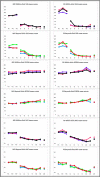Efficacy of the Modifying Phonation Intervals (MPI) Stuttering Treatment Program With Adults Who Stutter
- PMID: 25633470
- PMCID: PMC4610276
- DOI: 10.1044/2015_AJSLP-14-0076
Efficacy of the Modifying Phonation Intervals (MPI) Stuttering Treatment Program With Adults Who Stutter
Abstract
Purpose: This study compared a new adult stuttering treatment program (Modifying Phonation Intervals, or MPI) with the standard of care for reducing stuttered speech in adults (prolonged speech).
Method: Twenty-seven adults who stutter were assigned to either MPI or prolonged speech treatment, both of which used similar infrastructures. Speech and related variables were assessed in 3 within-clinic and 3 beyond-clinic speaking situations for participants who successfully completed all treatment phases.
Results: At transfer, maintenance, and follow-up, the speech of 14 participants who successfully completed treatment was similar to that of normally fluent adults. Successful participants also showed increased self-identification as a "normal speaker," decreased self-identification as a "stutterer," reduced short intervals of phonation, and some increased use of longer duration phonation intervals. Eleven successful participants received the MPI treatment, and 3 received the prolonged speech treatment.
Conclusions: Outcomes for successful participants were very similar for the 2 treatments. The much larger proportion of successful participants in the MPI group, however, combined with the predictive value of specific changes in PI durations suggest that MPI treatment was relatively more effective at assisting clients to identify and change the specific speech behaviors that are associated with successful treatment of stuttered speech in adults.
Figures





Similar articles
-
Evaluation of a stuttering treatment based on reduction of short phonation intervals.J Speech Lang Hear Res. 2001 Dec;44(6):1229-44. doi: 10.1044/1092-4388(2001/096). J Speech Lang Hear Res. 2001. PMID: 11776361
-
An investigation of the effects of a speech-restructuring treatment for stuttering on the distribution of intervals of phonation.J Fluency Disord. 2016 Dec;50:13-22. doi: 10.1016/j.jfludis.2016.09.001. Epub 2016 Sep 9. J Fluency Disord. 2016. PMID: 27865226
-
Phonation interval modification and speech performance quality during fluency-inducing conditions by adults who stutter.J Commun Disord. 2012 May-Jun;45(3):198-211. doi: 10.1016/j.jcomdis.2012.01.004. Epub 2012 Feb 6. J Commun Disord. 2012. PMID: 22365886 Free PMC article.
-
Recent advances in the treatment of stuttering: a theoretical perspective.J Commun Disord. 2005 Sep-Oct;38(5):375-93. doi: 10.1016/j.jcomdis.2005.03.001. J Commun Disord. 2005. PMID: 15963337 Review.
-
How effective is therapy for childhood stuttering? Dissecting and reinterpreting the evidence in light of spontaneous recovery rates.Int J Lang Commun Disord. 2005 Jul-Sep;40(3):359-74. doi: 10.1080/13682820400027735. Int J Lang Commun Disord. 2005. PMID: 16195194 Review.
References
-
- Andrews G., Guitar B., & Howie P. (1980). Meta-analysis of the effects of stuttering treatment. Journal of Speech and Hearing Disorders, 45, 287–307. - PubMed
-
- Boberg E., & Kully D. (1985). Comprehensive stuttering program. San Diego, CA: College-Hill.
-
- Boberg E., & Kully D. (1994). Long-term results of an intensive treatment program for adults and adolescents who stutter. Journal of Speech and Hearing Research, 37, 1050–1059. - PubMed
-
- Boersma P., & Weenink D. (2003). PRAAT (Version 4.2.07) [Computer software]. Amsterdam, the Netherlands: Institute of Phonetics Sciences, University of Amsterdam; Retrieved from http://www.praat.org
-
- Borden G. J., Baer T., & Kenney M. K. (1985). Onset of voicing in stuttered and fluent utterances. Journal of Speech and Hearing Research, 28, 363–372. - PubMed
Publication types
MeSH terms
Grants and funding
LinkOut - more resources
Full Text Sources
Medical
Research Materials
Miscellaneous

